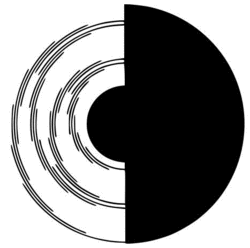- Benham's top
-
Benham's top, also called Benham's disk, is named after the English toymaker Charles Benham, who, in 1895, sold a top painted with the pattern shown. When the disk is spun, arcs of pale color — called Fechner colors or pattern induced flicker colors (PIFCs) — are visible at different places on the disk. Not everyone sees the same colors.
The phenomenon is not entirely understood. One possible reason people see colors may be that the color receptors in the human eye respond at different rates to red, green, and blue. More specifically, the latencies of the center and the surrounding mechanisms differ for the different types of color-specific ganglion cells.
The phenomenon originates from neural activity in the retina and spatial interactions in the primary visual cortex, which processes pattern recognition.[1] Research indicates that the blue-yellow opponent process accounts for all the different PIFCs.[2]
Benham's top and other PIFCs are being researched for use as a diagnostic tool for diseases of the eye and the visual track. It has shown particular promise in detecting Optic neuritis.[3]
References
- ^ von Campenhausen C, Schramme J (1995). "100 years of Benham's top in colour science". Perception 24 (6): 695–717. doi:10.1068/p240695. PMID 7478909.
- ^ Schramme J (1992). "Changes in pattern induced flicker colors are mediated by the blue-yellow opponent process". Vision Research 32 (11): 2129–34. doi:10.1016/0042-6989(92)90074-S. PMID 1304090.
- ^ Pilz J, Marre E (1993). "Pattern-induced flicker colors. An ophthalmologic examination method (Article in German)". Ophthalmologe 90 (2): 148–54. PMID 8490297.
External links
Categories:- Optical illusions
- Color
Wikimedia Foundation. 2010.


